AUCTORES
Globalize your Research
Research Article | DOI: https://doi.org/10.31579/2641-0419/094
1Director of Clinical Research, The Heart and Vascular Institute, Germantown, USA
2Parasympathetic & Sympathetic Nervous System Consultant, Franklin Cardiovascular Associates, Sewell, New Jersey – USA
3Physio PS, Inc., Atlanta, Georgia – USA
*Corresponding Author: Gary L Murray, The Heart and Vascular Institute, 7205 Wolf River Blvd, Germantown.
Citation: Gary L Murray and Joseph Colombo., (2020) Re-print: Maintenance (r) Alpha Lipoic Acid Reduces Sudden Cardiac Death in Geriatric Diabetes Mellitus II Patients. J, Clinical Cardiology and Cardiovascular Interventions, 3(9); Doi:10.31579/2641-0419/094
Copyright: © 2020 Gary L Murray, This is an open access article distributed under the Creative Commons Attribution License, which permits unrestricted use, distribution, and reproduction in any medium, provided the original work is properly cited
Received: 30 September 2020 | Accepted: 09 October 2020 | Published: 16 October 2020
Keywords: alpha lipoic acid; dabetic autonomic neuropathy; sudden death.
Background: Diabetes carries a two-fold risk of Sudden Cardiac Death (SCD). Diabetic Autonomic Neuropathy (DAN), often progressing to Cardiovascular Autonomic Neuropathy (CAN, critically low parasympathetic tone [P]), increases death 3.5-fold over 5 years, half sudden or non- renal. Oxidative stress is a major cause of DAN. Also, increased sympathetic tone (S), High Sympathovagal Balance [SB>2.5] increases SCD risk.
Objective: Dysautonomic diabetic II patients were treated with the antioxidant (r) Alpha Lipoic Acid (ALA), autonomic function followed, and Sudden Death (SD) compared to untreated patients. Methods: 133 patients (mean age 66y/o) with DAN or CAN, diagnosed using the ANX
3.0 Autonomic Monitor (Physio PS, Inc., Atlanta, GA) was offered (r)-ALA: 83 agreed (Group 1), and 50 refused (Group 2). P and S were re- measured up to 3 times/yr (mean f/u 6.31 yrs); SCDs were recorded.
Results: A 43% Relative Risk Reduction (RRR) in SCD occurred with (r)- ALA (25% SCD Group 1 vs. 44% SCD Group 2, p=0.0076). Initial to final patients with high SB or CAN were 21.7%-12% (p=0.010), 10.8%- 15.7% (p=0.045), Group 1 vs. 24%-22% (p=ns), 6%-12% (p=0.083), Group 2. Only Group 1 survivors increased mean resting P. The progressive increase in P’s decline, increasing CAN risk, in the other patients correlated with mortality (p<0.001) and (r) ALA dose. Initially, Group 1 had insignificantly less high SB (p=0.449) and significantly more CAN (p=0.013) vs. Group 2. Finally, Group 1 had significantly less high SB (p=0.0967) vs. Group 2, also improving to insignificantly more CAN (p=0.261).
Conclusion: (r)-ALA was associated with a 43% RRR of SCD and favorable P and S changes.
SCD-Sudden Cardiac Death,
DAN-Diabetic Autonomic Neuropathy,
CAN-Cardiovascular Autonomic Neuropathy,
P-Parasympathetic tone,
Diabetics have a two-fold increased risk of Sudden Cardiac Death (SCD), the most common cause of death in adult diabetics. Subgroup analyses have not explained this adequately [1]. Diabetic Autonomic Neuropathy (DAN) [2], carries a 53% 5yr. mortality, half of the deaths sudden [3]. DAN can progress to Cardiovascular Autonomic Neuropathy (CAN) in approximately 65% of patients with aging and diabetes duration [4]; CAN, critically low Parasympathetic tone (P), increased SCD in the Framingham Study [5]. Hyperglycemic- oxidative stress causes dysautonomia [6-8]. We hypothesized (r)-ALA, a natural, potent anti-oxidant, might reduce SCD in Type 2 Diabetics (DMII) with dysautonomias. We have shown previously (r)-ALA improves autonomics in Hypertension (HTN) [9] as well as Neurogenic Orthostatic Hypotension (NOH) [10].
In 2006, 133 consecutive DMII referrals for cardiovascular evaluation underwent P and S testing via ANX 3.0 Autonomic Monitoring (P&S Monitoring, Physio PS, Inc., Atlanta, GA). P&S were computed simultaneously and independently by concurrent, continuous time- frequency analysis of Respiratory Activity (RA) and Heart Rate Variability (HRV), as we detailed previously [11-17]. P&S srenormally; sitting LFa and RFa=0.5 to 10.0 bpm2; SB is age dependent=0.4 to 1.0 for geriatrics; stand LFa is ≥ 10% increase with respect to (wrt) sit; stand RFa is a decrease wrt sit. High SB is defined as>2.5, as established in our 483 patient study [18]. High SB and CAN define a high risk of mortality, Acute Coronary Syndromes (ACS), CHF, and Ventricular Tachycardia/Fibrillation (VT/VF) alone or as a composite endpoint [18].
In the 83 (r)-ALA patients (Group 1), P&S were recorded 2-3 mo. afterwards until maintenance dosage, then yearly. Non-(r)ALA patients (Group 2, refused (r)-ALA) were tested yearly. Exclusion criteria were (1) arrhythmia precluding HRV measurement, and (2) cancer within 5 yrs. The inclusion criterion was DM II with any abnormality of P or S. Informed consent was obtained for this open-label, un-blinded study. The cause of SD was determined from hospital records or death certificates. Out of hospital SCD was defined as pulse less SD of cardiac origin.
Group 1 patients were subcategorized: survivors, Group AA; non- survivors Group AD. Group 2 (Controls): survivors, Group NA; non- survivors, Group ND. All patients took aspirin. All patients had Cardiovascular Autonomic Reflex Test (CART) w/o isometric grip (grip has only 25% sensitivity for CAN) [19]. DAN was defined as any abnormality of S or P, or high SB. CAN was defined as P<0.10bpm2, or 2 abnormalities of CARTs. Median follow-up was 5 yrs. Mean age was 66 y/o. There were 83 males, 50 females. Upon referral, rhythm assessment (Holters ± event monitors) were performed if clinically indicated: Groups AA 60%, AD 57.1%, NA 60.7%, ND 31.8%.
The abbreviations are: Δ, change from initial to final; A1C, glucose form hemoglobin; (r) ALA ((r)Alpha-Lipoic Acid) (the r-isomer functional in humans); BMI (Body Mass Index); Bx (Baseline); CAN; DAN; dBP (Diastolic Blood Pressure); HL (Hyperlipidemia); HR (Heart Rate); Init (Initial); LFa ((Low Frequency area)=S)); LVEF (Left Ventricular Ejection Fraction); mg (milligrams); N (number); Nml (normal); ns (not significant); P (Parasympathetic tone); PE (Parasympathetic Excess); QTc (corrected QT); RFa ((Respiratory Frequency area)=P)); S (Sympathetic tone); SB (Sympathovagal Balance); sBP (systolic BP); SW (Sympathetic Withdrawal). Given the size of the cohort, statistical significance is p<0.100. Statistical significance was determined with either a two-tailed, student T-test or a Pearson correlation.
25% of (r)-ALA patients experienced SCD vs. 44% non-(r)-ALA patients, a 43% Relative Risk Reduction (RRR, p=0.0076 [Figure 1]), altering the natural history of DAN [3].
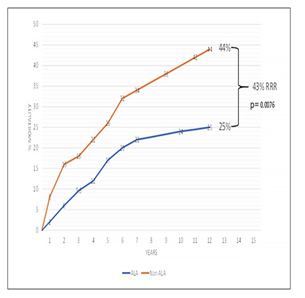
Figure 1: Sudden Death Mortality risk of a Diabetic type 2 cohort from a south-central USA cardiology practice. (r)ALA (blue curve) reduced this cohort’s relative risk ratio (RRR) by 43% (p=0.0076) as compared to controls (brown curve).
Demographics
Table 1 Survivor demographics Group AA had significantly more males and higher final A1C; their initial LVEF was insignificantly lower, factors not favoring survival [20-24]; tending to favor survival were insignificantly fewer with CAD (although all AA and NA patients were vascularized with normal stress tests), less Chronic Kidney Disease (CKD); and significantly more Angiotensin blocker therapy (ACEI or ARB, p<0.100) [20,25]. 11% more (r)-ALA patents required insulin. Control Group NA had significantly more females and lower final A1C; there were insignificantly higher initial LVEFs and insignificantly more patients on Empagliflozin, Liraglutid, and Metformin, tending to favor survival [26-29].
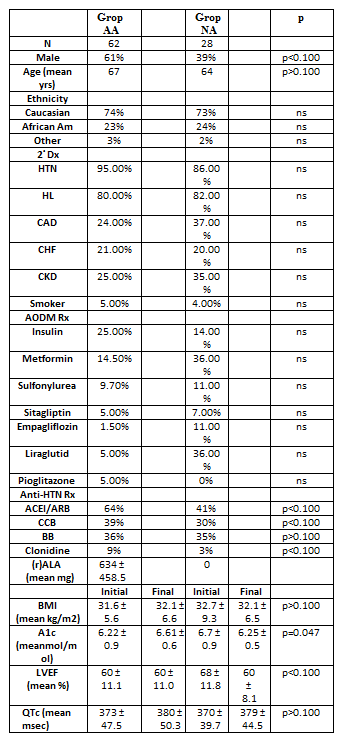
Note: 2° Dx=Secondary Diagnosis; ACEI=Angiotensin Converting Enzyme Inhibitor; ARB=Angiotensin Renin Blocker; BB=Beta-Blocker; CCB=Calcium Channel Blocker; HL=Hyperlipidemia; Rx=therapy.
Table 1: Survivor Patient Demographics.
Table 2 Non-Survivors. Group AD had significantly more males and higher A1C; there were insignificantly higher final BMI [24], lower LVEFs, more CHF, and less Metformin use, all tending unfavorably regarding survival. But 9% more took ACEI/ARBs (p<0.100). Control Group ND was 4 years older (p>0.100); QTc had no significance on SD, as SD increases when QTc is >450ms in males or >470ms in females [30]. Insignificantly more Group ND African Americans tends to favor SD [31]. CAD causes most adult SDs [24]. Although more SD patients had CAD vs. survivors, CAD prevalence was insignificantly different in Groups AD, ND.
Group AA vs. Group ND: Improved Group AA survival occurred despite Group ND having a normal final BMI (p=0.067), less HTN (p=0.021), greater use of Empagliflozin (p<0.100), Metformin (p<0.100), lower final A1C (p=0.034), and fewer males (p<0.100), all favoring less SCD in Group ND. DMII attenuates gender differences in SD [22]. Group ND was 3 yrs. Older (p=0.067) with more CAD (p<0.100); all were revascularized (normal myocardial perfusion stress tests). Fewer in Group AA took insulin (p<0.100). Initially, Group AA had 18.4% VT (1sustained) vs. 14.3% non-sustained in Group ND, p=0.3559.
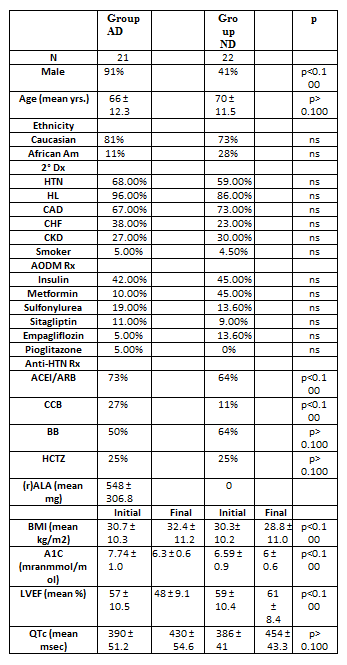
Note: HCTZ, hydrochlorothiazide. See Table 1 or Methods for other abbreviations.
Table 2: Non-Survivor Patient Demographics (Sudden Death Patients).
Autonomic Measures: Table 3: Survivors and SCD patients initial to final autonomic Measures. Mean Bx LFa, decreased in survivors (p=0.045), increasing in SCD (p=0.039). Bx RFa, increased in 55/90 patients (60%), by a mean 12.5% in survivors and severely decreased in 29/43 (67%) non-survivors, mean -59.5%, (p<0.0001). SB increased 17.6% in survivors, but had a greater increase in SCD to >2.5: +29.5% (p=0.064).
Non-Survivors demonstrated a more abnormal final alpha-S-response standing, SW (-24.4% vs. -13.8% [p=0.066]), indicating greater Bar receptor Reflex dysfunction, which increases SCD risk. PE upon standing developed more significantly in survivors (+65%) vs. SCD (+29%) because initial to final standing RFa increased in survivors vs. decreasing in SCD (p=0.022). In parallel, SCD patients experienced a dramatic 59.5% decrease in resting P in addition to SW. All P- and S- final values were lower in SCD, the lowest being resting P. Since HRV=S+P, HRV was lower in SCD (p<0.0001) mainly due to lower P.
Survivors
Group-AA, Survivors with (r)-ALA: (Table 4) A1C increased (increasing oxidative stress, p=0.047), inversely proportional to (r)- ALA dosage (p=0.071); but resting RFa increased proportionally (p=0.014). Average resting Bx LFa increased (p=0.095) as did resting Bx RFa (p=0.070). HRV increased. The mean initial standing response was SW. At final testing, 4 patients’ SW were relieved (p=0.097);
Consequently, BRS improved. One more patient demonstrated PE (p=0.098) (standing RFa increased) proportional to (r)-ALA dosage.

Note: HCTZ, hydrochlorothiazide; Standing represents positive head-up posture, equivalent to head-up tilt. See Table 1 or Methods for other abbreviations.
Table 3: Comparison between Survivors and Sudden Cardiac Death patients, Mean P&S Measures. See Methods for parameters’ normal ranges.

Note: (+), improved; (-), declined; Δ, change? Demonstrated; ns, not significant (p>0.100); See Table 1 or Methods for other abbreviations.
Table 4: Mean P&S measures for DM II Survivors on (r)ALA (GroupAA).
Group-NA, Survivors without (r)-ALA: (Table 5) Similar to Group- AA, the average initial P&S levels are normal, and given their age, SB is high (but lower than Group AA and not >2.5). Contrary to Group AA, final BxLFa decreased (p=0.075), as did BxRFa (and HRV). SB increased (p=0.088). Standing, Group-NA initially demonstrated normal P- and slightly low S-responses. Individually, 57.1% demonstrated SW. Of these, 81.3% demonstrated PE. At final testing, 2 patients’ SW were relieved; 5 relieved PE, different from the Group AA patients (p<0.027).
Group-NA, Survivors without (r)-ALA: (Table 5) Similar to Group- AA, the average initial P&S levels are normal, and given their age, SB is high (but lower than Group AA and not >2.5). Contrary to Group AA, final BxLFa decreased (p=0.075), as did BxRFa (and HRV). SB increased (p=0.088). Standing, Group-NA initially demonstrated normal P- and slightly low S-responses. Individually, 57.1% demonstrated SW. Of these, 81.3% demonstrated PE. At final testing, 2 patients’ SW were relieved; 5 relieved PE, different from the Group AA patients (p<0.027).
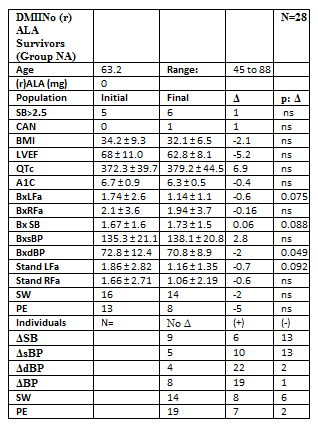
Note: (+), improved; (-), declined; Δ, change demonstrated; ns, not significant (p>0.100); See Table 1 or Methods for other abbreviations.
Table 5: Mean P&S measures for DM II Survivors not on (r)ALA (Group NA), the control group.
Survivors’ Mortality Risk: 13% Group AA patients demonstrated CAN initially, improving to 8.1%, proportional to (r)-ALA dose (p=0.004). Group AA was the only Group that increased resting BxRFa, (Table 4). Group-AA’s final RFa increased 36.2%, correlating with the dose of (r)-ALA (p=0.014). Group AA’s increase in resting BxLFa (Table 4) was mitigated by the increase in resting BxRFa, so the SB change was insignificant. Group NA had no CAN initially; increasing to 3.6%. This group’s average resting BxLFa decreased (34.5%); BxRFa fell 7.6%. SB (the average of 4 sec. ratios, not the ratio of these reported averages) significantly increased 3.6% (p=0.088), increasing MACE risk. In Tables 4 and 5, Group AA’s BxLFa and BxRFa were initially lower than Group NA’s (p<0.100), indicating lower HRV. Group AA increased both, decreasing mortality risk (Table 4). Group NA decreased both BxLFa (Table 5) (p=0.075) and BxRFa (p=ns), indicating an accelerated progression towards increased mortality risk (decreased HRV).
Non-Survivors
Group AD, Non-Survivors with (r)-ALA: (Table 6) Initial P&S levels are below normal and lowest of all Groups (lowest HRV). Given their age, SB is high (but not >2.5). Final LFa increased (p=0.047); RFa decreased (p=0.098); and SB increased to 2.72. Resting P protects against VT/VF and silent ischemia [21,32-36]; seven progressed to CAN (p=0.080), not surprising since initial BxRFa was so severely depressed. Group AD was beyond help. Standing, 57% of Group AD initially demonstrated PE; 33% ended with PE (p=0.061) and 57% ended with SW (p=0.037) indicative of BRS dysfunction (increases SCD). Finally, Group AD’s, average stand LFa was SW. These Sympathetic results are significantly similar to Group AA (p=0.061). However, the P-responses, are different (p=0.185).
Group ND, Non-Survivors without (r)-ALA: (Table 7) Initial resting BxLFa, resting BxRFa, were normal; SB high for age (but not >2.5 Final BxLFa decreased, p=0.100; BxRFa severely decreased, p=0.020. Two more patients (67%) developed CAN (p=0.020) in spite of initially good BxRFa. Group ND’s initial standing P was normal, but S showed SW. Final average S-stand remained SW; P barely normalized. The P-responses as compared with the Group-AA are different (p=0.106).
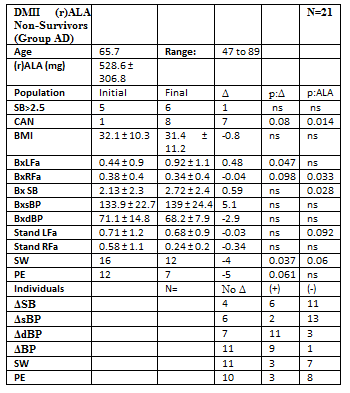
Note: (+), improved; (-), declined; Δ, change? Demonstrated; ns, not significant (p>0.100); See Table 1or Methods for other abbreviations.
Table 6: Mean P&S measures for DM II Non-Survivors on (r)ALA (Group AD).
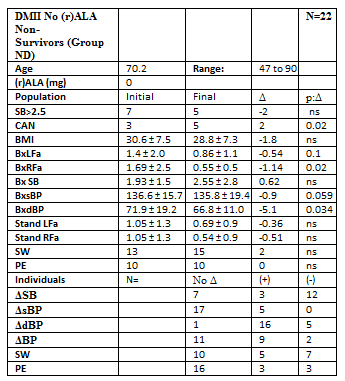
Note: (+), improved; (-), declined; Δ, change demonstrated; ns, not significant (p > 0.100); See Table 1or Methods for other abbreviations.
Table 7: Mean P&S measures for DM II Non-Survivors not on (r)ALA (Group ND).
Mortality Risk: Resting BxRFa decreased in both Groups (Tables 6&7): 10.5%, Group AD and 67.5%, Group ND (p=0.033); a higher risk of developing CAN. Final SB was >2.5 in both, which we have shown increases MACE 700% [18]. SB greater than 2.5 with CAN is particularly deadly in both Groups, and final average standing response was SW (impaired BRS), increasing SCD as well. BxLFa increased in Group AD (Table 6) by 109.1% vs. decreasing 38.6% in Group ND (Table 7, p=0.100), causing increased SB in Group AD.
In Group ND, despite the decrease in S, the severe decrease in resting BxRFa increased SB anyway. Two more patients had CAN. Non- survivors’ (r)ALA preserved their severely lowest P and S (LOWEST HRV) even in death. Group ND’s final BxLFa and BxRFa fell severely to the 2nd lowest among all Groups. CAN and high SB were most frequent in Groups AD and ND.
Traditional Standards Comparison: Comparing the gold standard of CARTs, without isometric hand-grip, to any abnormality of P&S Monitoring for diagnosing DAN or CAN, CARTs’ sensitivity was 48.2% of Group 1 and 30.0% of Group 2 patients; an overall unsatisfactory sensitivity of 41.4%.
Administration of (r)ALA resulted in a 43% RRR of SCD, rather than the demographics that may have favored survival in Controls. Rapid separation of the SCD curves (Figure 1) strongly implies treatment effect. Lower initial HRV, Group 1 vs. Group 2, p<0.0001, predicted SCD: AA 1.83 vs. AD 0.82, p=0.0171; NA 4.14 vs. ND 3.09,
p=0.0051. More initial CAN ((rALA 10.8% vs. Controls 6%, p=0.0013) and initial BRS dysfunction ((r)ALA 63.9% vs. Controls 58%, p=0.0044) predicted SCD better than recorded VT. (r)ALA preserved P and S vs. Controls. Those with the lowest P&S (HRV) died. Reduced HRV is a common thread in SCD Only Group AA demonstrated an increase in final, resting P (and HRV); P reduces VT/VF and silent ischemia [21,32-36], increasing 36.2% vs. a 7.6% decrease for Group NA, a 10.5% decrease for Group AD, and a 67.5% decrease for Group ND.
The progressive increase in the decline of resting P indicated mortality, from the lowest decline in resting P in Group NA, to the next greater decline in Group AD, to those with the greatest decline, Group ND (p<0.001). Changes in P were proportional to (r)ALA dose. These trends are not found in the other physiologic measures: BMI, LVEF, and QTc; and only different between the survivors’ A1Cs (Group AA vs. Group NA, p=0.034). Since SW and PE can cause both NOH and systemic HTN [9,10]. DMII patients not on (r)ALA might experience orthostasis, or labile HTN. HTN could be secondary (neurogenic), and is over twice as well controlled treating the primary SW ± PE [9] than treating the BP per se. (r)ALA preserved P and S, especially P, in survivors and non-survivors. (r)ALA is a natural, powerful thiol antioxidant. (r)ALA restores and recycles vitamins A,C,E and glutathione [9,10,34].
It improves hyperglycemia, endothelial dysfunction, nitric oxide levels (protective against VT/VF, silent ischemia [37-40]), reduces nuclear kappa B, and is essential for certain mitochondrial oxidative enzymes. (r)ALA prevents diabetic-induced reduction of the afferent limb function of the baroreceptor reflex (BR) [41], reducing MACE. SW, found in 50% to 74% of patients, failed to correct in 88% of Group NA and all SCD patients. SW disappeared substantially only in Group AA, 59.7% reduced to 53.2%, p=0.097, decreasing SCD risk. The other most common, and most important, P&S finding was low resting P in 56% to 81% of patients, improving only in Group AA (initial 56%, final 9%; p=0.070), vs. Group NA (initial 29%, final 43%; p=0.098), and worsening most severely in Group ND patients, a 67% reduction in RFa vs. 10.5% reduction in Group AD (p=0.020).
CAN decreased 37.5% in Group AA vs. an increase of 67% in Group ND. 29% of Group AD had high SB vs. 50% in Group ND (p=0.037). More CAN in Group 2 increased mortality; high SB increased mortality risk in Group 1. Group 1’s autonomic profiles generally stabilized or improved (HRV); Group 2’s deteriorated, especially a 59.5% decrease in resting P, reducing Group 2’s ability to combat VT/VF, silent ischemia, and life stresses. Standard deviations decreased over time, with the most decreases correlating with the (r)ALA dosage. The pleotropic effects of (r)ALA likely contributed to
SCD reduction. Increased nitric oxide improves P&S, endothelial dysfunction, protects against VT/VF and silent ischemia [37-40]. Decreased nitric oxide levels prolong QTc [37]. Improved mitochondrial function should reduce SCD also [42]. Asymptomatic SW (BR dysfunction) was the most common presentation of DAN. Approximately 90% of patients had HTN, presumed to be essential (primary), not possibly secondary to DAN. Ultimately, CAN with, or without, dangerously high SB can develop while under our care. How simple it is to diagnose and treat dysautonomia early; how tragic it may be not to.
Clearly Auctoresonline and particularly Psychology and Mental Health Care Journal is dedicated to improving health care services for individuals and populations. The editorial boards' ability to efficiently recognize and share the global importance of health literacy with a variety of stakeholders. Auctoresonline publishing platform can be used to facilitate of optimal client-based services and should be added to health care professionals' repertoire of evidence-based health care resources.

Journal of Clinical Cardiology and Cardiovascular Intervention The submission and review process was adequate. However I think that the publication total value should have been enlightened in early fases. Thank you for all.

Journal of Women Health Care and Issues By the present mail, I want to say thank to you and tour colleagues for facilitating my published article. Specially thank you for the peer review process, support from the editorial office. I appreciate positively the quality of your journal.
Journal of Clinical Research and Reports I would be very delighted to submit my testimonial regarding the reviewer board and the editorial office. The reviewer board were accurate and helpful regarding any modifications for my manuscript. And the editorial office were very helpful and supportive in contacting and monitoring with any update and offering help. It was my pleasure to contribute with your promising Journal and I am looking forward for more collaboration.

We would like to thank the Journal of Thoracic Disease and Cardiothoracic Surgery because of the services they provided us for our articles. The peer-review process was done in a very excellent time manner, and the opinions of the reviewers helped us to improve our manuscript further. The editorial office had an outstanding correspondence with us and guided us in many ways. During a hard time of the pandemic that is affecting every one of us tremendously, the editorial office helped us make everything easier for publishing scientific work. Hope for a more scientific relationship with your Journal.
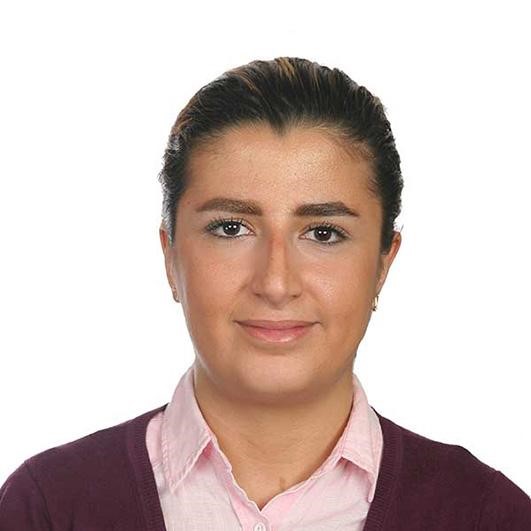
The peer-review process which consisted high quality queries on the paper. I did answer six reviewers’ questions and comments before the paper was accepted. The support from the editorial office is excellent.

Journal of Neuroscience and Neurological Surgery. I had the experience of publishing a research article recently. The whole process was simple from submission to publication. The reviewers made specific and valuable recommendations and corrections that improved the quality of my publication. I strongly recommend this Journal.

Dr. Katarzyna Byczkowska My testimonial covering: "The peer review process is quick and effective. The support from the editorial office is very professional and friendly. Quality of the Clinical Cardiology and Cardiovascular Interventions is scientific and publishes ground-breaking research on cardiology that is useful for other professionals in the field.

Thank you most sincerely, with regard to the support you have given in relation to the reviewing process and the processing of my article entitled "Large Cell Neuroendocrine Carcinoma of The Prostate Gland: A Review and Update" for publication in your esteemed Journal, Journal of Cancer Research and Cellular Therapeutics". The editorial team has been very supportive.

Testimony of Journal of Clinical Otorhinolaryngology: work with your Reviews has been a educational and constructive experience. The editorial office were very helpful and supportive. It was a pleasure to contribute to your Journal.

Dr. Bernard Terkimbi Utoo, I am happy to publish my scientific work in Journal of Women Health Care and Issues (JWHCI). The manuscript submission was seamless and peer review process was top notch. I was amazed that 4 reviewers worked on the manuscript which made it a highly technical, standard and excellent quality paper. I appreciate the format and consideration for the APC as well as the speed of publication. It is my pleasure to continue with this scientific relationship with the esteem JWHCI.

This is an acknowledgment for peer reviewers, editorial board of Journal of Clinical Research and Reports. They show a lot of consideration for us as publishers for our research article “Evaluation of the different factors associated with side effects of COVID-19 vaccination on medical students, Mutah university, Al-Karak, Jordan”, in a very professional and easy way. This journal is one of outstanding medical journal.
Dear Hao Jiang, to Journal of Nutrition and Food Processing We greatly appreciate the efficient, professional and rapid processing of our paper by your team. If there is anything else we should do, please do not hesitate to let us know. On behalf of my co-authors, we would like to express our great appreciation to editor and reviewers.

As an author who has recently published in the journal "Brain and Neurological Disorders". I am delighted to provide a testimonial on the peer review process, editorial office support, and the overall quality of the journal. The peer review process at Brain and Neurological Disorders is rigorous and meticulous, ensuring that only high-quality, evidence-based research is published. The reviewers are experts in their fields, and their comments and suggestions were constructive and helped improve the quality of my manuscript. The review process was timely and efficient, with clear communication from the editorial office at each stage. The support from the editorial office was exceptional throughout the entire process. The editorial staff was responsive, professional, and always willing to help. They provided valuable guidance on formatting, structure, and ethical considerations, making the submission process seamless. Moreover, they kept me informed about the status of my manuscript and provided timely updates, which made the process less stressful. The journal Brain and Neurological Disorders is of the highest quality, with a strong focus on publishing cutting-edge research in the field of neurology. The articles published in this journal are well-researched, rigorously peer-reviewed, and written by experts in the field. The journal maintains high standards, ensuring that readers are provided with the most up-to-date and reliable information on brain and neurological disorders. In conclusion, I had a wonderful experience publishing in Brain and Neurological Disorders. The peer review process was thorough, the editorial office provided exceptional support, and the journal's quality is second to none. I would highly recommend this journal to any researcher working in the field of neurology and brain disorders.

Dear Agrippa Hilda, Journal of Neuroscience and Neurological Surgery, Editorial Coordinator, I trust this message finds you well. I want to extend my appreciation for considering my article for publication in your esteemed journal. I am pleased to provide a testimonial regarding the peer review process and the support received from your editorial office. The peer review process for my paper was carried out in a highly professional and thorough manner. The feedback and comments provided by the authors were constructive and very useful in improving the quality of the manuscript. This rigorous assessment process undoubtedly contributes to the high standards maintained by your journal.

International Journal of Clinical Case Reports and Reviews. I strongly recommend to consider submitting your work to this high-quality journal. The support and availability of the Editorial staff is outstanding and the review process was both efficient and rigorous.

Thank you very much for publishing my Research Article titled “Comparing Treatment Outcome Of Allergic Rhinitis Patients After Using Fluticasone Nasal Spray And Nasal Douching" in the Journal of Clinical Otorhinolaryngology. As Medical Professionals we are immensely benefited from study of various informative Articles and Papers published in this high quality Journal. I look forward to enriching my knowledge by regular study of the Journal and contribute my future work in the field of ENT through the Journal for use by the medical fraternity. The support from the Editorial office was excellent and very prompt. I also welcome the comments received from the readers of my Research Article.

Dear Erica Kelsey, Editorial Coordinator of Cancer Research and Cellular Therapeutics Our team is very satisfied with the processing of our paper by your journal. That was fast, efficient, rigorous, but without unnecessary complications. We appreciated the very short time between the submission of the paper and its publication on line on your site.

I am very glad to say that the peer review process is very successful and fast and support from the Editorial Office. Therefore, I would like to continue our scientific relationship for a long time. And I especially thank you for your kindly attention towards my article. Have a good day!

"We recently published an article entitled “Influence of beta-Cyclodextrins upon the Degradation of Carbofuran Derivatives under Alkaline Conditions" in the Journal of “Pesticides and Biofertilizers” to show that the cyclodextrins protect the carbamates increasing their half-life time in the presence of basic conditions This will be very helpful to understand carbofuran behaviour in the analytical, agro-environmental and food areas. We greatly appreciated the interaction with the editor and the editorial team; we were particularly well accompanied during the course of the revision process, since all various steps towards publication were short and without delay".

I would like to express my gratitude towards you process of article review and submission. I found this to be very fair and expedient. Your follow up has been excellent. I have many publications in national and international journal and your process has been one of the best so far. Keep up the great work.

We are grateful for this opportunity to provide a glowing recommendation to the Journal of Psychiatry and Psychotherapy. We found that the editorial team were very supportive, helpful, kept us abreast of timelines and over all very professional in nature. The peer review process was rigorous, efficient and constructive that really enhanced our article submission. The experience with this journal remains one of our best ever and we look forward to providing future submissions in the near future.

I am very pleased to serve as EBM of the journal, I hope many years of my experience in stem cells can help the journal from one way or another. As we know, stem cells hold great potential for regenerative medicine, which are mostly used to promote the repair response of diseased, dysfunctional or injured tissue using stem cells or their derivatives. I think Stem Cell Research and Therapeutics International is a great platform to publish and share the understanding towards the biology and translational or clinical application of stem cells.

I would like to give my testimony in the support I have got by the peer review process and to support the editorial office where they were of asset to support young author like me to be encouraged to publish their work in your respected journal and globalize and share knowledge across the globe. I really give my great gratitude to your journal and the peer review including the editorial office.

I am delighted to publish our manuscript entitled "A Perspective on Cocaine Induced Stroke - Its Mechanisms and Management" in the Journal of Neuroscience and Neurological Surgery. The peer review process, support from the editorial office, and quality of the journal are excellent. The manuscripts published are of high quality and of excellent scientific value. I recommend this journal very much to colleagues.

Dr.Tania Muñoz, My experience as researcher and author of a review article in The Journal Clinical Cardiology and Interventions has been very enriching and stimulating. The editorial team is excellent, performs its work with absolute responsibility and delivery. They are proactive, dynamic and receptive to all proposals. Supporting at all times the vast universe of authors who choose them as an option for publication. The team of review specialists, members of the editorial board, are brilliant professionals, with remarkable performance in medical research and scientific methodology. Together they form a frontline team that consolidates the JCCI as a magnificent option for the publication and review of high-level medical articles and broad collective interest. I am honored to be able to share my review article and open to receive all your comments.

“The peer review process of JPMHC is quick and effective. Authors are benefited by good and professional reviewers with huge experience in the field of psychology and mental health. The support from the editorial office is very professional. People to contact to are friendly and happy to help and assist any query authors might have. Quality of the Journal is scientific and publishes ground-breaking research on mental health that is useful for other professionals in the field”.

Dear editorial department: On behalf of our team, I hereby certify the reliability and superiority of the International Journal of Clinical Case Reports and Reviews in the peer review process, editorial support, and journal quality. Firstly, the peer review process of the International Journal of Clinical Case Reports and Reviews is rigorous, fair, transparent, fast, and of high quality. The editorial department invites experts from relevant fields as anonymous reviewers to review all submitted manuscripts. These experts have rich academic backgrounds and experience, and can accurately evaluate the academic quality, originality, and suitability of manuscripts. The editorial department is committed to ensuring the rigor of the peer review process, while also making every effort to ensure a fast review cycle to meet the needs of authors and the academic community. Secondly, the editorial team of the International Journal of Clinical Case Reports and Reviews is composed of a group of senior scholars and professionals with rich experience and professional knowledge in related fields. The editorial department is committed to assisting authors in improving their manuscripts, ensuring their academic accuracy, clarity, and completeness. Editors actively collaborate with authors, providing useful suggestions and feedback to promote the improvement and development of the manuscript. We believe that the support of the editorial department is one of the key factors in ensuring the quality of the journal. Finally, the International Journal of Clinical Case Reports and Reviews is renowned for its high- quality articles and strict academic standards. The editorial department is committed to publishing innovative and academically valuable research results to promote the development and progress of related fields. The International Journal of Clinical Case Reports and Reviews is reasonably priced and ensures excellent service and quality ratio, allowing authors to obtain high-level academic publishing opportunities in an affordable manner. I hereby solemnly declare that the International Journal of Clinical Case Reports and Reviews has a high level of credibility and superiority in terms of peer review process, editorial support, reasonable fees, and journal quality. Sincerely, Rui Tao.

Clinical Cardiology and Cardiovascular Interventions I testity the covering of the peer review process, support from the editorial office, and quality of the journal.

Clinical Cardiology and Cardiovascular Interventions, we deeply appreciate the interest shown in our work and its publication. It has been a true pleasure to collaborate with you. The peer review process, as well as the support provided by the editorial office, have been exceptional, and the quality of the journal is very high, which was a determining factor in our decision to publish with you.
The peer reviewers process is quick and effective, the supports from editorial office is excellent, the quality of journal is high. I would like to collabroate with Internatioanl journal of Clinical Case Reports and Reviews journal clinically in the future time.

Clinical Cardiology and Cardiovascular Interventions, I would like to express my sincerest gratitude for the trust placed in our team for the publication in your journal. It has been a true pleasure to collaborate with you on this project. I am pleased to inform you that both the peer review process and the attention from the editorial coordination have been excellent. Your team has worked with dedication and professionalism to ensure that your publication meets the highest standards of quality. We are confident that this collaboration will result in mutual success, and we are eager to see the fruits of this shared effort.

Dear Dr. Jessica Magne, Editorial Coordinator 0f Clinical Cardiology and Cardiovascular Interventions, I hope this message finds you well. I want to express my utmost gratitude for your excellent work and for the dedication and speed in the publication process of my article titled "Navigating Innovation: Qualitative Insights on Using Technology for Health Education in Acute Coronary Syndrome Patients." I am very satisfied with the peer review process, the support from the editorial office, and the quality of the journal. I hope we can maintain our scientific relationship in the long term.
Dear Monica Gissare, - Editorial Coordinator of Nutrition and Food Processing. ¨My testimony with you is truly professional, with a positive response regarding the follow-up of the article and its review, you took into account my qualities and the importance of the topic¨.

Dear Dr. Jessica Magne, Editorial Coordinator 0f Clinical Cardiology and Cardiovascular Interventions, The review process for the article “The Handling of Anti-aggregants and Anticoagulants in the Oncologic Heart Patient Submitted to Surgery” was extremely rigorous and detailed. From the initial submission to the final acceptance, the editorial team at the “Journal of Clinical Cardiology and Cardiovascular Interventions” demonstrated a high level of professionalism and dedication. The reviewers provided constructive and detailed feedback, which was essential for improving the quality of our work. Communication was always clear and efficient, ensuring that all our questions were promptly addressed. The quality of the “Journal of Clinical Cardiology and Cardiovascular Interventions” is undeniable. It is a peer-reviewed, open-access publication dedicated exclusively to disseminating high-quality research in the field of clinical cardiology and cardiovascular interventions. The journal's impact factor is currently under evaluation, and it is indexed in reputable databases, which further reinforces its credibility and relevance in the scientific field. I highly recommend this journal to researchers looking for a reputable platform to publish their studies.

Dear Editorial Coordinator of the Journal of Nutrition and Food Processing! "I would like to thank the Journal of Nutrition and Food Processing for including and publishing my article. The peer review process was very quick, movement and precise. The Editorial Board has done an extremely conscientious job with much help, valuable comments and advices. I find the journal very valuable from a professional point of view, thank you very much for allowing me to be part of it and I would like to participate in the future!”

Dealing with The Journal of Neurology and Neurological Surgery was very smooth and comprehensive. The office staff took time to address my needs and the response from editors and the office was prompt and fair. I certainly hope to publish with this journal again.Their professionalism is apparent and more than satisfactory. Susan Weiner

My Testimonial Covering as fellowing: Lin-Show Chin. The peer reviewers process is quick and effective, the supports from editorial office is excellent, the quality of journal is high. I would like to collabroate with Internatioanl journal of Clinical Case Reports and Reviews.

My experience publishing in Psychology and Mental Health Care was exceptional. The peer review process was rigorous and constructive, with reviewers providing valuable insights that helped enhance the quality of our work. The editorial team was highly supportive and responsive, making the submission process smooth and efficient. The journal's commitment to high standards and academic rigor makes it a respected platform for quality research. I am grateful for the opportunity to publish in such a reputable journal.
My experience publishing in International Journal of Clinical Case Reports and Reviews was exceptional. I Come forth to Provide a Testimonial Covering the Peer Review Process and the editorial office for the Professional and Impartial Evaluation of the Manuscript.

I would like to offer my testimony in the support. I have received through the peer review process and support the editorial office where they are to support young authors like me, encourage them to publish their work in your esteemed journals, and globalize and share knowledge globally. I really appreciate your journal, peer review, and editorial office.
Dear Agrippa Hilda- Editorial Coordinator of Journal of Neuroscience and Neurological Surgery, "The peer review process was very quick and of high quality, which can also be seen in the articles in the journal. The collaboration with the editorial office was very good."

I would like to express my sincere gratitude for the support and efficiency provided by the editorial office throughout the publication process of my article, “Delayed Vulvar Metastases from Rectal Carcinoma: A Case Report.” I greatly appreciate the assistance and guidance I received from your team, which made the entire process smooth and efficient. The peer review process was thorough and constructive, contributing to the overall quality of the final article. I am very grateful for the high level of professionalism and commitment shown by the editorial staff, and I look forward to maintaining a long-term collaboration with the International Journal of Clinical Case Reports and Reviews.
To Dear Erin Aust, I would like to express my heartfelt appreciation for the opportunity to have my work published in this esteemed journal. The entire publication process was smooth and well-organized, and I am extremely satisfied with the final result. The Editorial Team demonstrated the utmost professionalism, providing prompt and insightful feedback throughout the review process. Their clear communication and constructive suggestions were invaluable in enhancing my manuscript, and their meticulous attention to detail and dedication to quality are truly commendable. Additionally, the support from the Editorial Office was exceptional. From the initial submission to the final publication, I was guided through every step of the process with great care and professionalism. The team's responsiveness and assistance made the entire experience both easy and stress-free. I am also deeply impressed by the quality and reputation of the journal. It is an honor to have my research featured in such a respected publication, and I am confident that it will make a meaningful contribution to the field.

"I am grateful for the opportunity of contributing to [International Journal of Clinical Case Reports and Reviews] and for the rigorous review process that enhances the quality of research published in your esteemed journal. I sincerely appreciate the time and effort of your team who have dedicatedly helped me in improvising changes and modifying my manuscript. The insightful comments and constructive feedback provided have been invaluable in refining and strengthening my work".

I thank the ‘Journal of Clinical Research and Reports’ for accepting this article for publication. This is a rigorously peer reviewed journal which is on all major global scientific data bases. I note the review process was prompt, thorough and professionally critical. It gave us an insight into a number of important scientific/statistical issues. The review prompted us to review the relevant literature again and look at the limitations of the study. The peer reviewers were open, clear in the instructions and the editorial team was very prompt in their communication. This journal certainly publishes quality research articles. I would recommend the journal for any future publications.

Dear Jessica Magne, with gratitude for the joint work. Fast process of receiving and processing the submitted scientific materials in “Clinical Cardiology and Cardiovascular Interventions”. High level of competence of the editors with clear and correct recommendations and ideas for enriching the article.

We found the peer review process quick and positive in its input. The support from the editorial officer has been very agile, always with the intention of improving the article and taking into account our subsequent corrections.
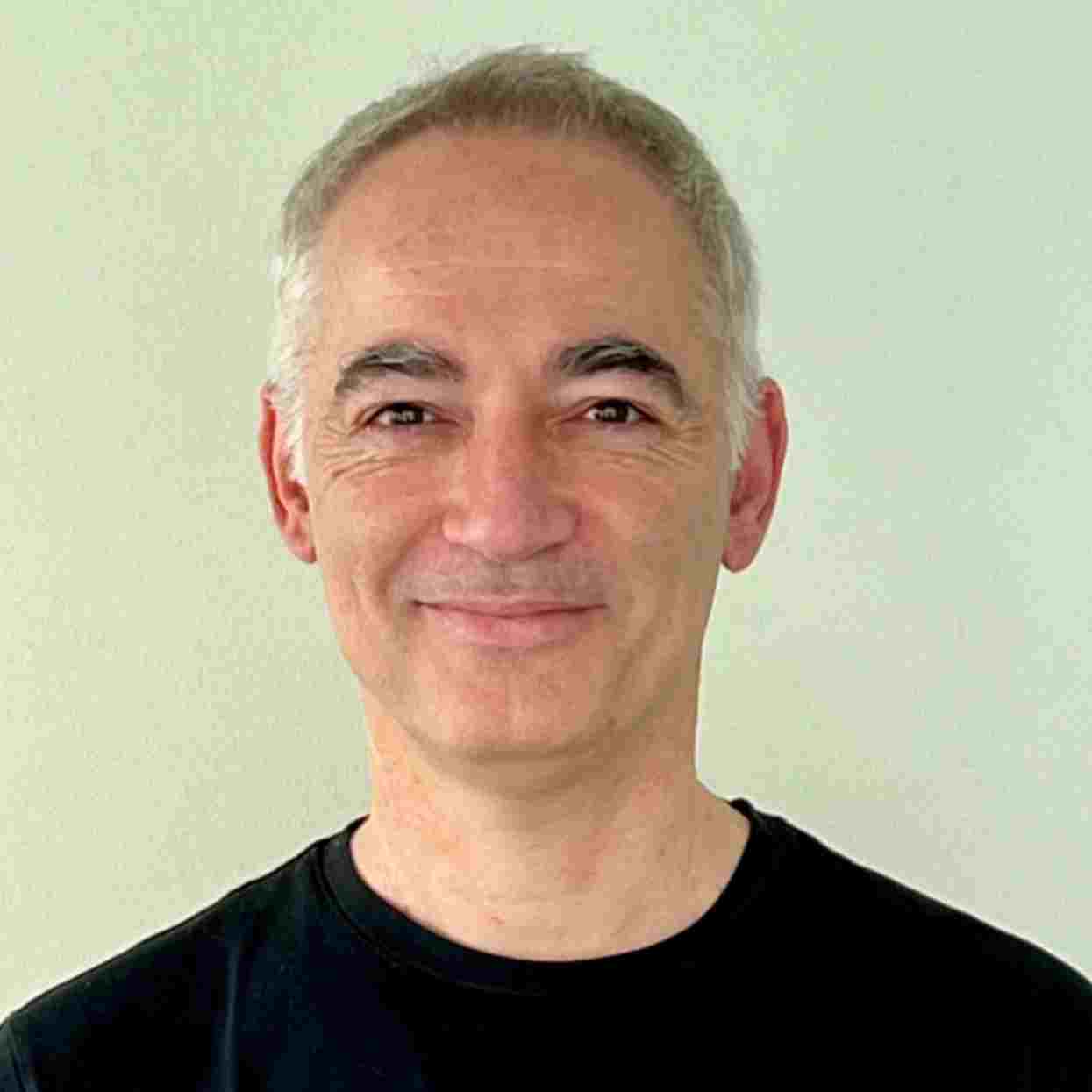
My article, titled 'No Way Out of the Smartphone Epidemic Without Considering the Insights of Brain Research,' has been republished in the International Journal of Clinical Case Reports and Reviews. The review process was seamless and professional, with the editors being both friendly and supportive. I am deeply grateful for their efforts.
To Dear Erin Aust – Editorial Coordinator of Journal of General Medicine and Clinical Practice! I declare that I am absolutely satisfied with your work carried out with great competence in following the manuscript during the various stages from its receipt, during the revision process to the final acceptance for publication. Thank Prof. Elvira Farina

Dear Jessica, and the super professional team of the ‘Clinical Cardiology and Cardiovascular Interventions’ I am sincerely grateful to the coordinated work of the journal team for the no problem with the submission of my manuscript: “Cardiometabolic Disorders in A Pregnant Woman with Severe Preeclampsia on the Background of Morbid Obesity (Case Report).” The review process by 5 experts was fast, and the comments were professional, which made it more specific and academic, and the process of publication and presentation of the article was excellent. I recommend that my colleagues publish articles in this journal, and I am interested in further scientific cooperation. Sincerely and best wishes, Dr. Oleg Golyanovskiy.

Dear Ashley Rosa, Editorial Coordinator of the journal - Psychology and Mental Health Care. " The process of obtaining publication of my article in the Psychology and Mental Health Journal was positive in all areas. The peer review process resulted in a number of valuable comments, the editorial process was collaborative and timely, and the quality of this journal has been quickly noticed, resulting in alternative journals contacting me to publish with them." Warm regards, Susan Anne Smith, PhD. Australian Breastfeeding Association.
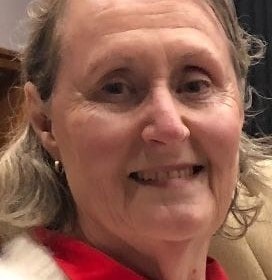
Dear Jessica Magne, Editorial Coordinator, Clinical Cardiology and Cardiovascular Interventions, Auctores Publishing LLC. I appreciate the journal (JCCI) editorial office support, the entire team leads were always ready to help, not only on technical front but also on thorough process. Also, I should thank dear reviewers’ attention to detail and creative approach to teach me and bring new insights by their comments. Surely, more discussions and introduction of other hemodynamic devices would provide better prevention and management of shock states. Your efforts and dedication in presenting educational materials in this journal are commendable. Best wishes from, Farahnaz Fallahian.
Dear Maria Emerson, Editorial Coordinator, International Journal of Clinical Case Reports and Reviews, Auctores Publishing LLC. I am delighted to have published our manuscript, "Acute Colonic Pseudo-Obstruction (ACPO): A rare but serious complication following caesarean section." I want to thank the editorial team, especially Maria Emerson, for their prompt review of the manuscript, quick responses to queries, and overall support. Yours sincerely Dr. Victor Olagundoye.

Dear Ashley Rosa, Editorial Coordinator, International Journal of Clinical Case Reports and Reviews. Many thanks for publishing this manuscript after I lost confidence the editors were most helpful, more than other journals Best wishes from, Susan Anne Smith, PhD. Australian Breastfeeding Association.
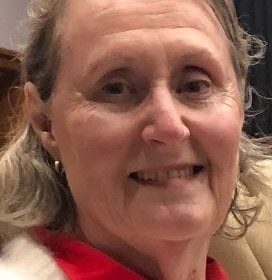
Dear Agrippa Hilda, Editorial Coordinator, Journal of Neuroscience and Neurological Surgery. The entire process including article submission, review, revision, and publication was extremely easy. The journal editor was prompt and helpful, and the reviewers contributed to the quality of the paper. Thank you so much! Eric Nussbaum, MD
Dr Hala Al Shaikh This is to acknowledge that the peer review process for the article ’ A Novel Gnrh1 Gene Mutation in Four Omani Male Siblings, Presentation and Management ’ sent to the International Journal of Clinical Case Reports and Reviews was quick and smooth. The editorial office was prompt with easy communication.

Dear Erin Aust, Editorial Coordinator, Journal of General Medicine and Clinical Practice. We are pleased to share our experience with the “Journal of General Medicine and Clinical Practice”, following the successful publication of our article. The peer review process was thorough and constructive, helping to improve the clarity and quality of the manuscript. We are especially thankful to Ms. Erin Aust, the Editorial Coordinator, for her prompt communication and continuous support throughout the process. Her professionalism ensured a smooth and efficient publication experience. The journal upholds high editorial standards, and we highly recommend it to fellow researchers seeking a credible platform for their work. Best wishes By, Dr. Rakhi Mishra.

Dear Jessica Magne, Editorial Coordinator, Clinical Cardiology and Cardiovascular Interventions, Auctores Publishing LLC. The peer review process of the journal of Clinical Cardiology and Cardiovascular Interventions was excellent and fast, as was the support of the editorial office and the quality of the journal. Kind regards Walter F. Riesen Prof. Dr. Dr. h.c. Walter F. Riesen.

Dear Ashley Rosa, Editorial Coordinator, International Journal of Clinical Case Reports and Reviews, Auctores Publishing LLC. Thank you for publishing our article, Exploring Clozapine's Efficacy in Managing Aggression: A Multiple Single-Case Study in Forensic Psychiatry in the international journal of clinical case reports and reviews. We found the peer review process very professional and efficient. The comments were constructive, and the whole process was efficient. On behalf of the co-authors, I would like to thank you for publishing this article. With regards, Dr. Jelle R. Lettinga.

Dear Clarissa Eric, Editorial Coordinator, Journal of Clinical Case Reports and Studies, I would like to express my deep admiration for the exceptional professionalism demonstrated by your journal. I am thoroughly impressed by the speed of the editorial process, the substantive and insightful reviews, and the meticulous preparation of the manuscript for publication. Additionally, I greatly appreciate the courteous and immediate responses from your editorial office to all my inquiries. Best Regards, Dariusz Ziora

Dear Chrystine Mejia, Editorial Coordinator, Journal of Neurodegeneration and Neurorehabilitation, Auctores Publishing LLC, We would like to thank the editorial team for the smooth and high-quality communication leading up to the publication of our article in the Journal of Neurodegeneration and Neurorehabilitation. The reviewers have extensive knowledge in the field, and their relevant questions helped to add value to our publication. Kind regards, Dr. Ravi Shrivastava.

Dear Clarissa Eric, Editorial Coordinator, Journal of Clinical Case Reports and Studies, Auctores Publishing LLC, USA Office: +1-(302)-520-2644. I would like to express my sincere appreciation for the efficient and professional handling of my case report by the ‘Journal of Clinical Case Reports and Studies’. The peer review process was not only fast but also highly constructive—the reviewers’ comments were clear, relevant, and greatly helped me improve the quality and clarity of my manuscript. I also received excellent support from the editorial office throughout the process. Communication was smooth and timely, and I felt well guided at every stage, from submission to publication. The overall quality and rigor of the journal are truly commendable. I am pleased to have published my work with Journal of Clinical Case Reports and Studies, and I look forward to future opportunities for collaboration. Sincerely, Aline Tollet, UCLouvain.

Dear Ms. Mayra Duenas, Editorial Coordinator, International Journal of Clinical Case Reports and Reviews. “The International Journal of Clinical Case Reports and Reviews represented the “ideal house” to share with the research community a first experience with the use of the Simeox device for speech rehabilitation. High scientific reputation and attractive website communication were first determinants for the selection of this Journal, and the following submission process exceeded expectations: fast but highly professional peer review, great support by the editorial office, elegant graphic layout. Exactly what a dynamic research team - also composed by allied professionals - needs!" From, Chiara Beccaluva, PT - Italy.

Dear Maria Emerson, Editorial Coordinator, we have deeply appreciated the professionalism demonstrated by the International Journal of Clinical Case Reports and Reviews. The reviewers have extensive knowledge of our field and have been very efficient and fast in supporting the process. I am really looking forward to further collaboration. Thanks. Best regards, Dr. Claudio Ligresti
Dear Chrystine Mejia, Editorial Coordinator, Journal of Neurodegeneration and Neurorehabilitation. “The peer review process was efficient and constructive, and the editorial office provided excellent communication and support throughout. The journal ensures scientific rigor and high editorial standards, while also offering a smooth and timely publication process. We sincerely appreciate the work of the editorial team in facilitating the dissemination of innovative approaches such as the Bonori Method.” Best regards, Dr. Matteo Bonori.
